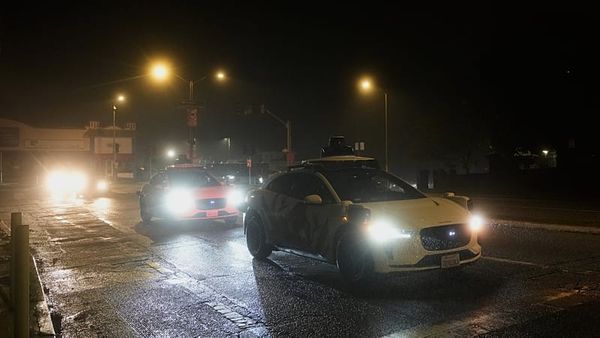
The first iPhone wasn't an immediate hit. Critics lambasted Apple for ditching the ubiquitous keypad and opting for a fully digital touchscreen interface. CEOs of the day—like Microsoft head and Zune creator, Steve Ballmer—called it "nothing more than a luxury bauble."
Eighteen years later, our monkey brains couldn’t comprehend a world without screens. Most hard buttons have been relegated to the history books, while touchscreens rule daily life.
But from the first iPhone, it took another decade still for touchscreen technology to make its way into vehicles. Tesla pioneered the idea with the Model S, which had (and still has) a giant tablet display plopped atop its dashboard. Other automakers quickly followed suit, tossing touchscreens into every vehicle from the cheapest compact sedan to the priciest pickup.

Customer demand largely drove the rise of in-car touchscreens—people wanted that same smartphone technology in their cars. And that’s still mostly true. But, as with any good capitalist venture, automotive executives also saw this as an opportunity to cut costs.
Rather than manufacturing and installing dozens of tiny knobs and dials in every vehicle, one large touchscreen or a single bank of haptic controls could manage many of those same functions, saving companies millions. Tesla’s massive screen, for example, controls the radio, A/C, windshield wipers, safety systems, and even the shifter itself.
More recently, the ability to add things over the air—instead of ripping out an entire setup and starting over—made it easier for manufacturers to introduce new features without much of a lift. Steve Jobs himself predicted the rise of OTA updates during the iPhone’s introductory press conference. As with many things, he was right.

But while touchscreens and haptic controls were beloved initially, automakers’ over-reliance on those features made them less desirable as time went on. Eventually, everything was haptic or touch-capacitive; you couldn’t roll down a window or adjust a seat setting without fiddling with some hardly responsive touch control. And soon, customers and safety watchdogs started to push back.
In 2017, a AAA study showed that drivers lingered for an average of 40 seconds on-screen when trying to perform basic functions like programming navigation or sending a text message. Even with the car moving at just 25 miles per hour, a vehicle would travel nearly five football fields in the 40 seconds drivers have their eyes off the road.
Last year, the European New Car Assessment Program (NCAP) revamped its rating system in an attempt to curb touchscreen distractions with a rule that five primary functions must have physical buttons or switches: the horn, windshield wipers, turn signals, hazard lights, and SOS features. Automakers would need to comply with the new rule by January 1, 2026, to achieve a five-star safety rating in Europe.

"The overuse of touchscreens is an industry-wide problem, with almost every vehicle-maker moving key controls onto central touchscreens, obliging drivers to take their eyes off the road and raising the risk of distraction crashes," Matthew Avery, director of strategic development at Euro NCAP, told The UK Times last year.
"New Euro NCAP tests due in 2026 will encourage manufacturers to use separate, physical controls for basic functions in an intuitive manner, limiting eyes-off-road time and therefore promoting safer driving."
It’s a win for fans of buttons.
'The overuse of touchscreens is an industry-wide problem, with almost every vehicle-maker moving key controls onto central touchscreens...'
The US, unfortunately, remains mostly agnostic when considering the relative safety of screens. Neither the National Highway Traffic Safety Administration (NHTSA) nor the Insurance Institute for Highway Safety (IIHS) has any such measure related to touchscreen safety. In 2022, though, NHTSA proposed updates to its New Car Assessment program related to in-car distractions, noting specifically, "emerging vehicle technologies related to driver distraction."
But in the three years since, nothing has been made official.
Although the US may not enforce safety rules related to in-car touchscreens (at least, not yet), automakers globally have already started making the switch back to physical controls. Much like the initial demand for touchscreens in the early teens, the reversal is being driven largely by negative feedback.

Volkswagen bore the brunt of that customer displeasure in 2020; people absolutely hated the touch-capacitive controls of the then-new ID.3 and ID.4 models. So much so, in fact, that only a few years later, VW essentially admitted defeat.
CEO Thomas Schaffer (who took over from the previous regime in 2022) said that touch-capactive controls "definitely did a lot of damage" and that the company would be reintroducing tactile controls into the cabins of many of its vehicles, which we’ve seen already on products like the Golf and Taos.
"We had frustrated customers who shouldn't be frustrated," Schaffer noted in an interview with Autocar. "So we've spent a lot of time now—working through really systematically—on what all the functions are that a customer usually touches when using a vehicle."

And Volkswagen isn’t alone. Hyundai executives have spoken up about keeping hard buttons in their vehicles based on customer feedback. Senior Vice President of Design Simon Loasby said, "You really don’t want people to look at the screen." Meanwhile, Head of Design SangYup Lee told Motor1 that, "Haptic [buttons] are cool, but if it's not helping others, it's not a good feature."
When Porsche introduced the latest Cayenne, the company made it a point to include physical dials for certain features, specifically for those customers fed up with touch controls. Porsche's director of user experience design, Ivo van Hulten, spoke with Ars Technica in 2023:
"We do a lot of [research] sessions all over the world, in all markets—also in the US. So, for example, we know that in the US, physical controls for climate control are very important."
'Haptic [buttons] are cool, but if it's not helping others, it's not a good feature.'
Mercedes-Benz—inventor of the Hyperscreen—even has some regrets with its over-reliance on touch controls. In an interview with ABC News, design lead Gorden Wagener said that big screens are "not luxury."
"You have a better—and bigger—TV at home, right? And every car has a big screen. So we have to create luxury beyond the screen. That's why I talk about craftsmanship and sophistication. There's so much emphasis on making [Mercedes] vehicles better."

And this problem isn’t exclusive to the US or Europe. In China, more than anywhere, we’re seeing an explosion of in-car touchscreen technology. The latest Auto Shanghai show was slipshod with all manner of screen-centric vehicles, from a Buick concept with “floating” displays to a Honda sports sedan with as many as six screens. Production cars from brands like BYD and Chery follow the Tesla route by baking most functions into a center screen.
But, as far as we can tell, Chinese automakers haven’t had nearly as much negative feedback as those in the US and Europe.
The touchscreen discussion has also taken flame on social media, with more users critical of the technology in recent months and years. A post on the r/ChangeMyView subreddit entitled, "Touchscreens in cars are incredibly stupid and actually quite dangerous," has over 1,000 likes and a few hundred comments as of writing. Many of the commenters agree with the user’s sentiment. One commenter noted:
Physical controls are absolutely safer and more convenient in many circumstances, though there are situations where a large screen can offer tangible benefits to the driver and passengers, particularly for maps and cameras, and some media, settings, and maintenance functions.
Another comnenter said:
For anything that needs to be controlled or adjusted during the drive, it needs to have physical controls. For everything else, the touch screen is better. There are lots of car settings that get controlled while the vehicle is stopped, especially in modern vehicles.
Thankfully, the tides are turning—slowly as they may be. What once seemed like a unique opportunity to reinvent the in-car experience, while simultaneously cutting costs, has become an annoyance for customers. And automakers realize that.
While some companies still won't budge (cough, Tesla, cough), other brands are already hard at work adding buttons back into their vehicles. And that’s great news, not just for functionality, but for safety—and most importantly, everyone’s sanity.







